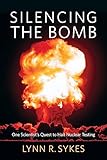Silencing the Bomb : One Scientist's Quest to Halt Nuclear Testing / Lynn R. Sykes.
Material type: TextPublisher: New York, NY : Columbia University Press, [2018]Copyright date: ©2017Description: 1 online resource : 40 b&w and 10 color illustrationsContent type:
TextPublisher: New York, NY : Columbia University Press, [2018]Copyright date: ©2017Description: 1 online resource : 40 b&w and 10 color illustrationsContent type: - 9780231182485
- 9780231544191
- 341.7/34 23
- online - DeGruyter
- Issued also in print.
| Item type | Current library | Call number | URL | Status | Notes | Barcode | |
|---|---|---|---|---|---|---|---|
 eBook
eBook
|
Biblioteca "Angelicum" Pont. Univ. S.Tommaso d'Aquino Nuvola online | online - DeGruyter (Browse shelf(Opens below)) | Online access | Not for loan (Accesso limitato) | Accesso per gli utenti autorizzati / Access for authorized users | (dgr)9780231544191 |
Frontmatter -- CONTENTS -- Acknowledgments -- Introduction -- 1. A HURRIED TRIP TO MOSCOW IN 1974 TO NEGOTIATE THE THRESHOLD NUCLEAR TEST BAN TREATY -- 2. DEVELOPMENT AND TESTING OF NUCLEAR WEAPONS -- 3. FROM THE EARLY NEGOTIATIONS TO HALT NUCLEAR TESTING TO THE LIMITED TEST BAN TREATY OF 1963 -- 4. ATTEMPTS TO HIDE NUCLEAR TESTS: THE BIG-HOLE EVASION SCHEME -- 5. U.S. OVERESTIMATION OF SIZES OF SOVIET UNDERGROUND EXPLOSIONS: 1961-1974 -- 6. NEW METHODS TO IDENTIFY UNDERGROUND TESTS: 1963-1973 -- 7. CONGRESSIONAL HEARINGS ON A COMPREHENSIVE TEST BAN -- 8. PEACEFUL NUCLEAR EXPLOSIONS -- 9. HEATED CONTROVERSIES OVER YIELDS OF SOVIET TESTS AND AN UNSUCCESSFUL ATTEMPT AT A CTBT -- 10. CONTINUED DEBATE ABOUT YIELDS, ACCUSATIONS OF SOVIET CHEATING ON THE THRESHOLD TREATY, AND ITS ENTRY INTO FORCE -- 11. RENEWED INTEREST IN A CTBT, THE OTA REPORT, AND THE GROUP OF SCIENTIFIC EXPERTS: 1979-1996 -- 12. DEALING WITH "PROBLEM" OR "ANOMALOUS" EVENTS IN THE USSR AND RUSSIAN REPUBLIC: 1972-2009 -- 13. NEGOTIATING THE COMPREHENSIVE TEST BAN: GLOBAL MONITORING, 1993-2016 -- 14. MONITORING NUCLEAR TESTS SITES AND COUNTRIES OF SPECIAL CONCERN TO THE UNITED STATES -- 15. SENATE REJECTION OF THE CTBT IN 1999 -- 16. THE CTBT TASK FORCE AND THE 2002 AND 2012 REPORTS OF THE NATIONAL ACADEMIES -- 17. STRATEGIC NUCLEAR WEAPONS: SOVIET AND U.S. PARITY -- 18. NUCLEAR WAR, FALSE ALARMS, ACCIDENTS, ARMS CONTROL, AND WAYS FORWARD -- Glossary and Abbreviations -- References -- Index
restricted access online access with authorization star
http://purl.org/coar/access_right/c_16ec
In December 2016, the Bulletin of Atomic Scientists moved their iconic "Doomsday Clock" thirty seconds forward to two and a half minutes to midnight, the latest it has been set since 1952, the year of the first United States hydrogen bomb test. But a group of scientists-geologists, engineers, and physicists-has been fighting to turn back the clock. Since the dawn of the Cold War, they have advocated a halt to nuclear testing, their work culminating in the Comprehensive Test Ban Treaty, which still awaits ratification from China, Iran, North Korea-and the United States. The backbone of the treaty is every nation's ability to independently monitor the nuclear activity of the others. The noted seismologist Lynn R. Sykes, one of the central figures in the development of the science and technology used in monitoring, has dedicated his career to halting nuclear testing. In Silencing the Bomb, he tells the inside story behind scientists' quest for disarmament.Called upon time and again to testify before Congress and to inform the public, Sykes and his colleagues were, for much of the Cold War, among the only people on earth able to say with certainty when and where a bomb was tested and how large it was. Methods of measuring earthquakes, researchers realized, could also detect underground nuclear explosions. When politicians on both sides of the Iron Curtain attempted to sidestep disarmament or test ban treaties, Sykes was able to deploy the nascent science of plate tectonics to reveal the truth. Seismologists' discoveries helped bring about treaties limiting nuclear testing, but it was their activism that played a key role in the effort for peace. Full of intrigue, international politics, and hard science used for the global good, Silencing the Bomb is a timely and necessary chronicle of one scientist's efforts to keep the clock from striking midnight.
Issued also in print.
Mode of access: Internet via World Wide Web.
In English.
Description based on online resource; title from PDF title page (publisher's Web site, viewed 02. Mrz 2022)


